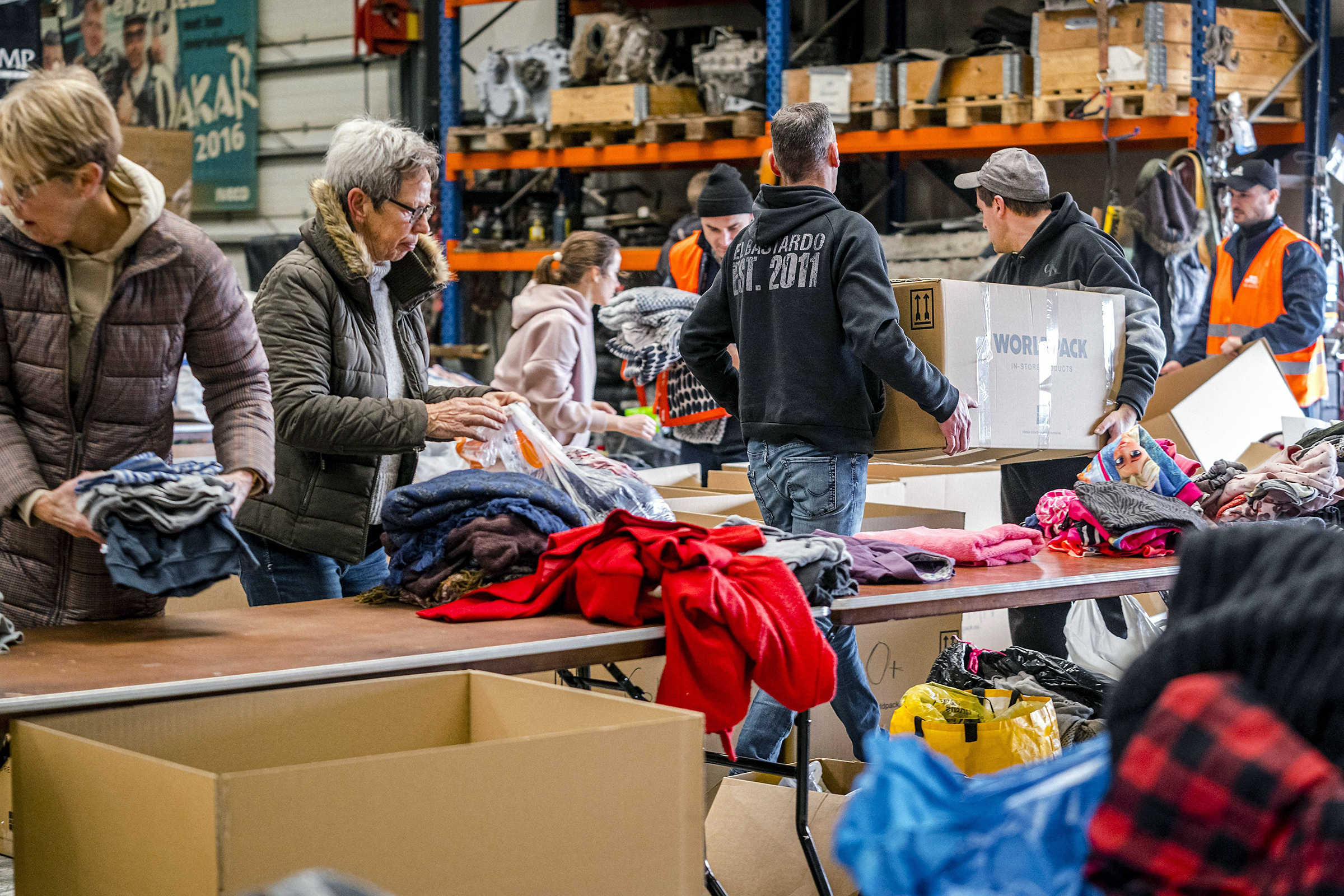
Indre Viltrakyte remembers what it means to live under Soviet rule. From a winter getaway in Bali with her family, the Lithuanian watched the news last week with impending gloom. A fashion designer turned renegade web3 creator, Viltrakyte is no stranger to the contentious politics of Eastern Europe; she was entangled in a 2013 lawsuit against her native Lithuania over free speech in her brand’s advertising, which ultimately went to the European Court of Human Rights. (She won.) The NFT project she now helms is even appropriately called The Rebels. But Putin’s advancement into Ukraine hit close to home in new ways. Because of the time difference, she was awake to watch Russia’s invasion unfold. “It was just like—devastating news,” she says. “The first thought that came to me was, How can we help? Because they will need help.”
After getting in touch with Ukrainian friends and connections, she started by converting about $15,000 in Ethereum to Bitcoin and donating personally to SaveLife.in.UA, or Come Back Alive, a Ukraine-based military charity that accepts BTC; it was the main group she could find that already had a public cryptocurrency wallet set up. Viltrakyte was not alone in her eagerness to contribute crypto to the Ukrainian cause. By Tuesday, the amount of crypto raised for Ukraine-based aid had surpassed $30 million, across a number of funds and efforts. One group even raised the equivalent of $1 million in a mere 30 seconds.
In Kyiv, Vitaliy Deynega, founder of Come Back Alive, is hard at work managing the many millions of dollars that are flowing into his organization’s coffers. A well-recognized Ukrainian charity with over 3 million followers on Facebook, his group buys equipment for the army: radios, drones, thermal night-vision setups. They set up an open crypto wallet about a year ago, and with the influx in support over the past week—both in crypto and fiat currency—they’ve already bought thousands of pieces of equipment for immediate distribution. “It was not that popular,” Deynega says of the crypto option in the past. “Not all that useful. But right now, in this hot stage of the war, it is extremely useful.” Sometimes, they don’t even have to convert the crypto to Euros, but can make purchases directly. Transacting solely in digital currency is not new to Ukrainians; Deynega references a banking system that supports transferring funds between bank cards. “Now instead of this banking card thing, we have this crypto thing, which gives us more flexibility because it’s international,” he says.
Read More: U.S. Companies Should Prepare for Putin’s ‘Gangster Diplomacy’ As Risk of Russian Cyberattacks Grows
To those working in web3—the next wave of decentralized virtual and digital platforms—the tendency of the community towards global philanthropy is natural. According to Pat Duffy, co-founder of donations platform The Giving Block, crypto-based giving has been steadily on the rise: a new study from Fidelity Charitable reports that “donor contributions of digital assets like Bitcoin soared nearly twelvefold over the previous year, totaling more than $330 million in total contributions in 2021.” Nearly half of crypto donors were likely to give $1,000 or more, compared to only 33% of all investors. And while Viltrakyte may have struggled to find crypto-friendly causes to contribute to during the first day of the conflict, Ukraine quickly realized the opportunity at hand: even the government opened up options for direct crypto donations.

Now, an ecosystem of platforms and crypto funds have popped up to facilitate these transfers. The Giving Block enables individuals to donate Bitcoin, Ethereum, or any of a wide list of crypto tokens to vetted humanitarian aid charities working in Ukraine—like Direct Relief and Save the Children—or to contribute to a general cause fund with a bundle of charities. “We reduce the amount of time nonprofits need to spend in this arena in order to fundraise effectively,” says Duffy. “And on the donor side, we build the connective tissue, the rails to nonprofits.” The goal: simplify giving.
Endaoment, another platform dedicated to streamlining crypto-philanthropy by turning donations directly into cash, has seen an influx of over $500,000 in the past five days for their Ukraine fund. “We lowered our minimum donations so that more people could donate, and we integrated PayPal donations so that people could donate with just regular dollars,” says CEO Robbie Heeger. “It’s so cool to see the financial infrastructure of the crypto ecosystem lined up with that emotional impetus to do something about it. And that’s what we’re seeing play out across web3. It’s not just about likes and retweets anymore; that social engagement can now be connected to the ultimate base financial infrastructure, globally.”
Ivan Vidyakin is the founder of Leleka Foundation, a U.S.-based 501c3 non-profit that distributes medical supplies, and one of the causes that Endaoment has been channeling funds toward. He confirms from his current home in Washington, D.C. that the crypto platform made good on its promises: Leleka received $200,000 in five days from all over the world, he says, with a portion of that from Endaoment. “They reached out to us, and we did the due diligence, because who wants to give us so much money?” he says. “But… it’s a legitimate organization. So we went ahead.” Already, they are working with on-ground partners in Ukraine to purchase and distribute needed supplies like first aid medical kits, tourniquets, and blood-stopping bandages.
Read More: How Open Source Intelligence Became the World’s Window Into the Ukraine Invasion
To Endaoment’s Heeger and others, this quick-connectivity and the inherent transparency of blockchain activity makes it an ideal platform for humanitarian aid. “Especially in moments when there are crises, it underscores the importance of seamless integration between the social networks that we use every day, and the financial infrastructure that has been historically siloed from those social networks,” he says.

Twitter in particular has been central to organizing. One of the buzzier donation efforts developed on that network. RELI3F was concocted by a hodgepodge of NFT enthusiasts: artists around the world, online community facilitators, and the popular Twitter connector Andrew Wang. Within a day, their collective launched a fund with 37 artists contributing NFT works; sales totaled over $1 million in less than a minute of the auction going live. They’ve directly wired about half of that to three causes that directly accept ETH—Come Back Alive, local media vetted by the Kyiv Independent, and medical group Hospitallers—while holding the other half as “priorities may shift,” they tweeted, and they want to be able to allocate to most-pressing needs in the days ahead. (Helpfully, anyone curious about how these donations are funneled can follow the blockchain trail by checking wallet addresses and viewing Etherscan transaction histories. While the donation pipeline has often been opaque in traditional philanthropy, crypto-based donations are transparent by nature.)
Ukrainian artist Vitaliy Raskalov is one of RELI3F’s organizers, coordinating with sources on the ground. “Right now, it’s a big challenge for them to change this amount of money,” he says of some of the funds learning to work with crypto. Still, there are places where transactions don’t require conversions. “You can pay [with crypto] in Poland and some other countries for equipment like bulletproof vests,” he says.
Raskalov and his RELI3F collaborators are happy to be doing something in the face of conflict and uncertainty, proving to themselves—and the world at large—that the NFT community is not just a scam, or a group of internet denizens trading jpegs. Aleksandra Artamonovskaja, a Ukrainian living in London who curated the initial art collection, has found purpose in fundraising; so have artists like Raskalov, Sasha Maslov, Hawkward, and Ravi Vora. “When you have a sense of at least helping in a tiny way, it helps you focus,” Artamonovskaja says. She left Ukraine in early February, and has been checking in on family there around the clock. On Monday evening, RELI3F coordinator Wang pulled together an impromptu Zoom with a dozen of the fund’s primary organizers and artist-contributors to discuss their work so far. “It’s not just about fungible tokens, or crypto making its way to another part of the world,” he said. “It’s because we have these social norms of helping each other and knowing each other and doing right by each other. All of our reputations are on the line for this. We lead with art.”
One of the most successful funds so far is UkraineDAO. Founded in part by Russian performance artist and activist Nadya Tolokonnikova—best known as one of the founding members of Pussy Riot—UkraineDAO raised over $4.2 million for Come Back Alive within three days of launching its first NFT collection, including from high-profile donors like Ethereum co-founder Vitalik Buterin, OnlyFans (responsible for a 500 ETH donation, about $1.5 million), and Reddit’s Alexis Ohanian. Donors can either donate crypto directly to the fund or invest in a “LOVE” token. “These tokens have NO utility nor value, but are a beautiful testament and reminder of your contribution to a noble cause,” the UkraineDAO website warns. For many crypto investors, the symbolism is worth the cost.

Read More: What Biden’s Sanctions on Russia Will Actually Do
That’s certainly the case for anyone purchasing the “Help Ukraine” meme token, $HUKR. Meme currencies, it turns out, can have a use case well beyond the jokes and quick cash: those who buy into this token are helping raise money for a number of Ukrainian causes, including via Endaoment’s distributed fund. To someone like Viltrakyte, watching her online community rally for her region, it’s been an overwhelming response. “Every group, every project that I’ve followed these past few days, they’re trying to do something,” she says. She knows of one individual who, alerted of the need on Discord, donated 8 BTC to one cause—about $3 million.
The blockchain is ultimately just ones and zeros; it’s inherently and permanently neutral, even in the face of war, and is just starting to prove itself as an efficient tool to move funds around the world fast, sidestepping the bureaucracy of our fiat currency institutions. In the last week, Bitcoin markets have spiked as Russians have turned away from the sinking ruble, seeking to evade intense sanctions. This crisis—the first instance of large-scale crypto-philanthropy mobilizing at once—is putting the blockchain to the test as a tool for good, too, however.
Before Russia’s invasion, Come Back Alive’s Deynega had quit his job and left Ukraine to travel. “But when I understood that we will have this war, I came back to participate,” he says. “I don’t feel very safe at this time, obviously. But, you know, it’s my job. So it’s okay.” Meanwhile the donations—millions each day—are “still flowing.”
More Must-Reads from TIME
- Cybersecurity Experts Are Sounding the Alarm on DOGE
- Meet the 2025 Women of the Year
- The Harsh Truth About Disability Inclusion
- Why Do More Young Adults Have Cancer?
- Colman Domingo Leads With Radical Love
- How to Get Better at Doing Things Alone
- Michelle Zauner Stares Down the Darkness
Write to Raisa Bruner at raisa.bruner@time.com